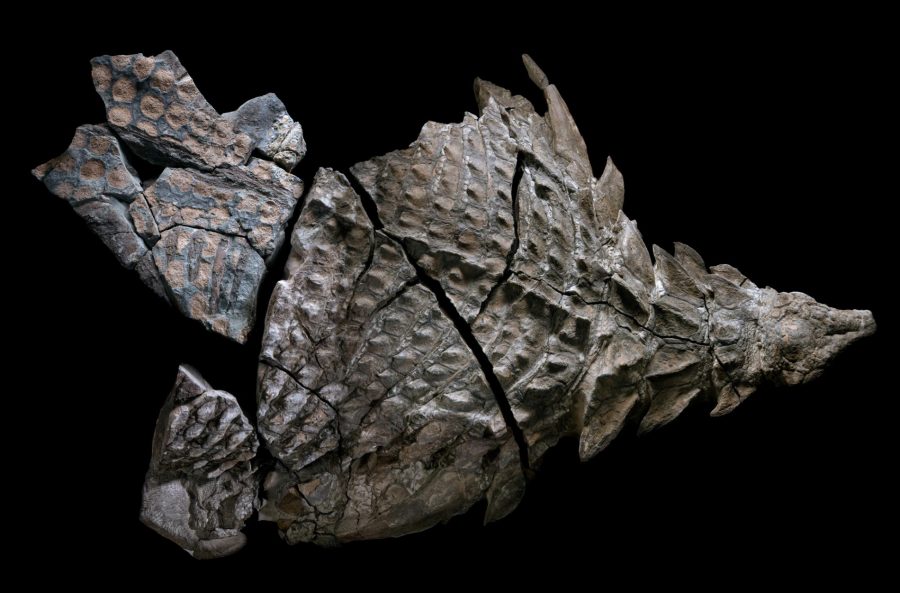The world’s best-preserved dinosaur was found in Alberta, Canada in 2011. The discovery came as a surprise, as it was found by a heavy-equipment operator named Shawn Funk who was working at the Millennium Mine, a vast pit 17 miles north of Fort McMurray, Alberta.
Funk was digging up the ground when he noticed something much harder than the surrounding rock, with odd colors. Funk quickly talked to his supervisor, and between the two of them, they examined the strange rocks, trying to figure out whether they were ribs or fossilized wood. They would later discover that they had found a nodosaur, an armored dinosaur who stretched 18 feet long and weighed nearly 3,000 pounds.

The dinosaur lived in what once was a seabed in Alberta
Researchers from the Royal Tyrell Museum in Drumheller, Alberta, took over the finding and have been studying the fossil ever since it was found in 2011. The nodosaur was missing its bottom part -from the hips down- although scientists believe it was originally fossilized whole. The specimen is by far the best fossil of a nodosaur ever found. Researchers believe the specimen died around 110 million years ago, although the cause of death is unclear.

“The shovel operator at the mine saw a block with a funny pattern and got in touch with a geologist,” said Dr. Don Brinkman, director of preservation and research at the Royal Tyrell Museum in Alberta, according to The New York Times. “We went up there and collected it.”
The nodosaur maintained its original shape as minerals in the ground of the Millenium Mine -which was once a seabed and now oil sands- kept the remains surprisingly intact, gradually turning the body into a fossil. The dinosaur even had fossilized skin and gut contents intact. Brinkman even described the nodosaur as a “dinosaur mummy.”
The sea that existed millions of years ago in Alberta was full of life and filled with giant reptiles that grew as long as 60 feet, while its shores were packed with dinosaurs. The area is known to be a site for fossil discoveries.
The nodosaur’s armor is incredibly well preserved
The specimen has not yet received a scientific description, and researchers are working on finding a name that fits the armored dinosaur. The fossil provided new insights into the structure of a nodosaur’s armor.
Usually, reconstructing armor requires guesswork, as the plates, called osteoderms, scatter in the decaying process. However, with the nodosaur fossil from Alberta, they found that not only did the osteoderms on the dinosaur preserved, but so did traces of the scales in between.

“I’ve been calling this one the Rosetta stone for armor,” said Donald Henderson, curator of dinosaurs at the Royal Tyrell Museum, according to National Geographic.
Mark Mitchell, a fossil preparator at the museum, said it would take years or maybe decades to understand the fossil they unearthed in Alberta. He noted that its skeleton remains mostly obscured in skin and armor, and as the dinosaur is almost too well preserved, examining the bones would require destroying its outer layers. The National Geographic Society funded CT scans to examine the fossil closely, but they have revealed little, as the rock remains opaque.

Jakob Vinther, a paleobiologist and expert on animal coloration from UK’s University of Bristol, said the nodosaur fossil’s most revolutionary features lie at its smallest scale: microscopic remnants of its original coloration. If Vinther can reconstruct its distribution, he could help reveal how the nodosaur navigated its environment and how it used its armor.
“This armor was clearly providing protection, but those elaborated horns on the front of its body would have been almost like a billboard,” said Vinther, according to National Geographic.
He noted that the horns could have worked as “advertisement” to intimidate its rivals. Chemical tests conducted on the nodosaur’s skin have hinted at the presence of red pigments, which contrasts with the horns’ light coloration.
The Royal Tyrell Museum unveiled the nodosaur’s fossil on Friday as the centerpiece of a new exhibit of fossils recovered from industrial sites in Alberta. Dr. Brinkman said that the museum has been careful not to inhibit industrial activity when retrieving ancient fossils so that the excavators are not afraid to call them when they discover something. He noted that the specimens would have never be recovered otherwise and that the museum gets two or three significant specimens each year.
Source: National Geographic

Seems he was quite the ‘horny’ critter!